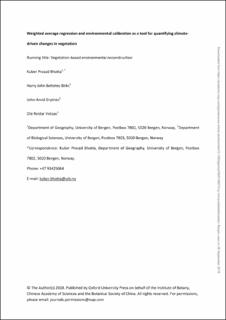| dc.contributor.author | Bhatta, Kuber Prasad | |
| dc.contributor.author | Birks, Harry John Betteley | |
| dc.contributor.author | Grytnes, John-Arvid | |
| dc.contributor.author | Vetaas, Ole Reidar | |
| dc.date.accessioned | 2021-04-23T08:05:09Z | |
| dc.date.available | 2021-04-23T08:05:09Z | |
| dc.date.created | 2019-01-07T20:44:12Z | |
| dc.date.issued | 2019 | |
| dc.Published | Journal of Plant Ecology. 2018, 12 (3), 460-473. | |
| dc.identifier.issn | 1752-9921 | |
| dc.identifier.uri | https://hdl.handle.net/11250/2739262 | |
| dc.description.abstract | Aims: Studies of the climatic responses of plant assemblages via vegetation-based environmental reconstructions by weighted averaging (WA) regression and calibration are a recent development in modern vegetation ecology. However, the performance of this technique for plot-based vegetation datasets has not been rigorously tested. We assess the estimation accuracy of the WA approach by comparing results, mainly the root mean square error of prediction (RMSEP) of WA regressions for six different vegetation datasets (total species, high-frequency species and low-frequency species as both abundance and incidence) each from two sites.
Methods: Vegetation-inferred environment (plot elevation) calibrated over time is used to quantify the elevational shift in species assemblages. Accuracy of the calibrations is assessed by comparing the linear regression models developed for estimating elevational shifts. The datasets were also used for the backward predictions to check the robustness of the forward predictions.
Important Findings: WA regression has a fairly high estimation accuracy, especially with species incidence datasets. However, estimation bias at the extremes of the environmental gradient is evident with all datasets. Out of eight sets (each set with a model for total species, low-frequency species and high-frequency species) of WA regression models, the lowest RMSEPs are produced in the four models based on the total species datasets and in three models based on the high-frequency species only. The inferred environment mirrored the estimation precision of the WA regressions, i.e. precise WA regression models produced more accurate calibrated environmental estimates, which, in turn, resulted in regression models with a higher adjusted r2 for estimating the elevational shift in the species assemblages. Reliable environmental estimates for plot-based datasets can be achieved by WA regression and calibration, although the edge effect may be evident if species turnover is high along an extensive environmental gradient. Species incidence (0/1) data may improve the estimation accuracy by minimizing any potential census and field estimation errors that are more likely to occur in species abundance datasets. Species data processing cannot guarantee the most reliable WA regression models. Instead, generally optimal estimations can be achieved by using all the species with a consistent taxonomy in the training and reconstruction datasets. | en_US |
| dc.language.iso | eng | en_US |
| dc.publisher | Oxford University Press | en_US |
| dc.title | Weighted average regression and environmental calibration as a tool for quantifying climate-driven changes in vegetation | en_US |
| dc.type | Journal article | en_US |
| dc.type | Peer reviewed | en_US |
| dc.description.version | acceptedVersion | en_US |
| dc.rights.holder | Copyright The Author(s) 2018. | en_US |
| cristin.ispublished | true | |
| cristin.fulltext | postprint | |
| cristin.qualitycode | 1 | |
| dc.identifier.doi | 10.1093/jpe/rty039 | |
| dc.identifier.cristin | 1651898 | |
| dc.source.journal | Journal of Plant Ecology | en_US |
| dc.source.40 | 12 | |
| dc.source.14 | 3 | |
| dc.source.pagenumber | 460-473 | en_US |
| dc.identifier.citation | Journal of Plant Ecology. 2019, 12 (3), 460–473. | en_US |
| dc.source.volume | 12 | en_US |
| dc.source.issue | 3 | en_US |
